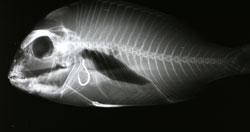Hook swallowing fish live to swim another day
Note: This content is stored on an archive website and may not be current or accurate. Contact us to clarify.

Fisheries researchers from the NSW Department of Primary Industries have gone to great depths to investigate the long-term outcomes of releasing fish that have swallowed hooks.
Research scientist Dr Paul Butcher said the study was carried out on three popular species - snapper, mulloway and yellowfin bream.
He said researchers focused on the long-term survival of the fish and examined whether hooks made of materials that break down faster could boost that survival rate.
“The results of the research show that simply cutting the line may be the best strategy to maximise the chances of long-term survival for mulloway, yellowfin bream and snapper that swallow a hook,” Dr Butcher said.
“Also it is apparent that for mulloway and snapper, hook shedding could be promoted by choosing carbon-steel hooks with narrow wire diameters and minimal protective coating.”
Dr Butcher said that with a combined total national recreational catch of more than 17 million fish a year, mulloway, yellowfin bream and snapper are three of the more popular coastal species.
“Minimum legal sizes, bag limits and simple sport angling mean that at least half of the catches are released and, in terms of conserving stocks, most released fish need to survive,” Dr Butcher said.
“Several studies have been done to try and validate this assumption, but most of the work has involved monitoring angled-and-released fish in cages for five days and typically survival has been about 70 to 100 per cent.
“Survival of lip hooked fish approached 100 per cent, but that number was dramatically less for fish that swallowed hooks,” he said.
Dr Butcher said 114 individuals of each species were caught and allowed to swallow either conventional or modified J-hooks. The modified hooks had small notches designed to reduce the wire diameter and were made from three different materials: stainless steel and nickel-plated and red-lacquer carbon steel.
“The survival rates were 65 per cent for mulloway over 63 days, 76 per cent for yellowfin bream over 37 days and 75 per cent for snapper over 42 days,” he said.
“Of the survivors 30, 61 and 77 per cent shed their hooks. The snapper managed to shed their hooks the fastest, over an average of nine days, followed by yellowfin bream in 17 days and mulloway in 29 days.”
Dr Butcher said hook shedding by snapper and mulloway was related to the amount of oxidation, while for yellowfin bream, the most important factor was their size.
He said all survivors were in good condition at the end of experiment and more research was planned to assess the utility of additional refinements to hooks to promote decay and shedding from these and other species.
The hook ingestion research was done by Southern Cross University PhD student Shane McGrath and funds from the recreational fishing trust were used to partially support the research
Email:

